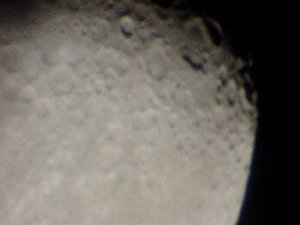Sunday, December 11, 2005
Low Cost Astrophotography
 There are lots of ways people with simple tools can do astrophotography. With the advent of cheap digital cameras, people can participate in imaging our skies as never before. I've written about solar projection before, where you can project the Sun's image onto a screen and photograph that to your hearts content. Another technique is simplicity itself. Focus your digital camera to infinity (landscape mode often will do this automatically), put the camera directly on the eyepiece of your telescope or binoculars and hey presto!
There are lots of ways people with simple tools can do astrophotography. With the advent of cheap digital cameras, people can participate in imaging our skies as never before. I've written about solar projection before, where you can project the Sun's image onto a screen and photograph that to your hearts content. Another technique is simplicity itself. Focus your digital camera to infinity (landscape mode often will do this automatically), put the camera directly on the eyepiece of your telescope or binoculars and hey presto!You get a nice, fuzzy, out of focus image like this one I took of the Moon after half-an-hours sweating.
If you have a very stable telescope mount and no wind (which I didn't have when I took this) and don't shake much when holding your camera (I do). Then you can actually get quite nice pictures. You are pretty much limited to the Moon, Venus at it's brightest and Jupiter at opposition, but you can take reasonable images with fairly simple equipment (my telescope here was an elderly 50 mm refractor mounted on at camera tripod). If you have a spare camera tripod, mounting your camera on the tripod makes taking non-shaky images a whole lot easier. If you want to get fancy, you can build or buy adaptors to mount your camera directly on your telescope. The latter site has a nice tutorial on adapting digital cameras to telescopes.
Of course, you could always get out the pencil and paper and sketch what you see.



 Click to read about or order
Click to read about or order Click to read about or order
Click to read about or order Click to read about or order
Click to read about or order Click to read about or order
Click to read about or order




